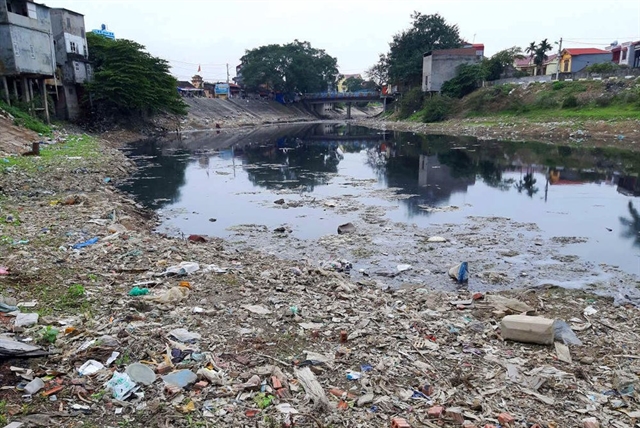 Environment
Environment

 |
| One of Hà Nội's most polluted riverbanks. — Photo baotainguyenmoitruong.vn |
HÀ NỘI — People in Hà Nội are not unfamiliar with the pollution in Tô Lịch, Đáy, Nhuệ rivers.
Black water, bad smells and garbage on the riverbanks are common themes in many of the capital's rivers, reports Báo Tài Nguyên & Môi Trường (Resources & Environment Newspaper).
Pollution is so bad that the river cannot be used for irrigation and cultivation, not to mention for daily life. This has affected the lives of citizens living nearby.
But some of the effects cannot be seen by the eye: methane and sulphur gases surround the area, poisoning and weakening the health of people.
Eighty per cent of unhandled wastewater is flowing directly to these rivers, according to recent studies.
Tô Lịch river is one of the most polluted. With a length of 14.6km, it has 300 drains from six districts discharging into Tô Lịch, with more than 150,000cu.m of unhandled wastewater.
Another river suffering from mass pollution is Nhuệ River, specifically in the section running through Hà Nội. Around 2,500 sources of wastewater, including industrial and household wastewater are directly discharged into the 63km of river.
Although facing a massive amount of wastewater, Hà Nội's eight treatment facilities are only capable of handling 35 per cent of the required amount. Yên Xá Wastewater Treatment Facility, capable of treating 270,000 cubic meters daily, is still in construction.
However, according to some experts, revitalising rivers does not only rely on centralised wastewater collection and treatment plants. Instead, wastewater should be collected and distributed along the drainage lines on both sides of the river, with the responsibility for coordination and direct management transferred to localities.
This will give clear, efficient and economical results, with many more benefits than a centralised treatment plant solution.
For many years, Hà Nội is still struggling with solutions and wastewater treatment projects that are expensive and have vague results. Dredging, stream cleaning the embankment, planting aquatic plants, and using Red River water to clean inner city flows has not fully solved the problems.
Therefore, the capital city should soon take measures to dredge, clear and treat water pollution, revitalising rivers as well as not filling existing lakes and ponds to implement urban housing projects, to ensure irrigation and drainage in the city.
The separation of the collection system of rainwater and domestic wastewater from industrial and medical discharge, are also being recommended by scientists as an idea to solve the problem. — VNS




